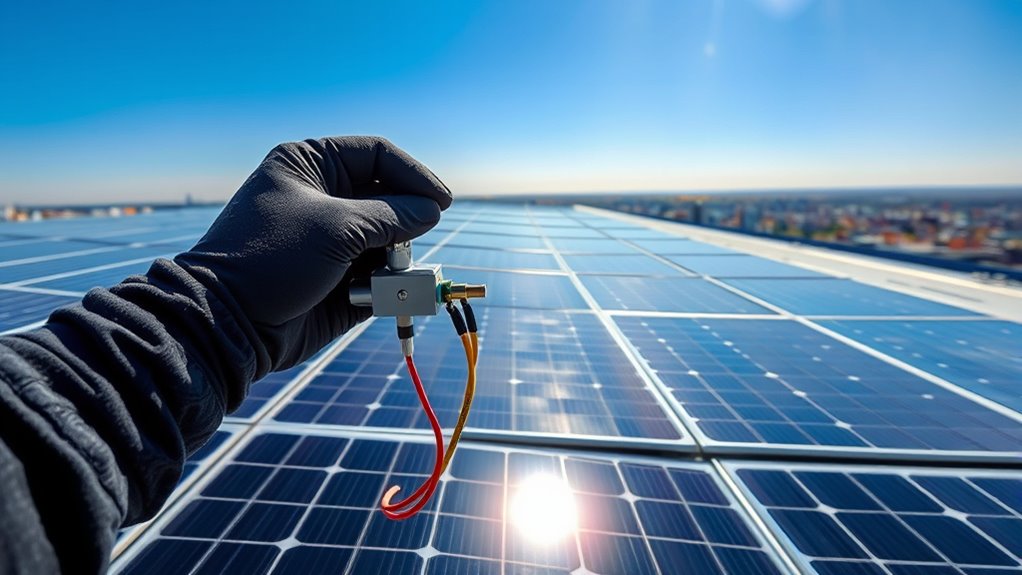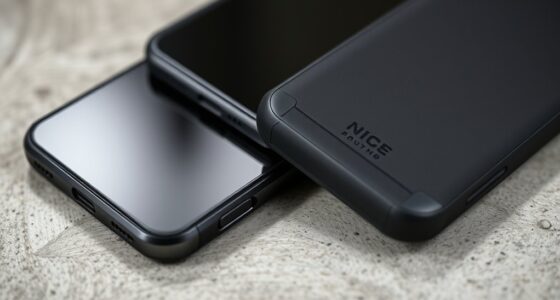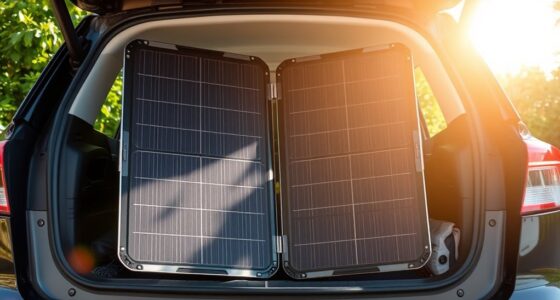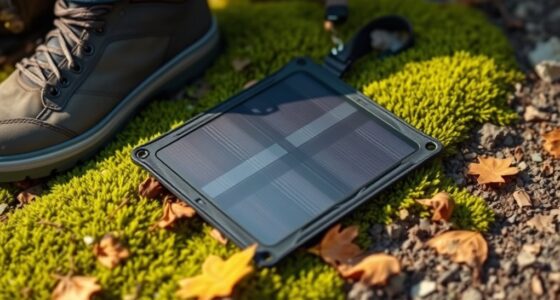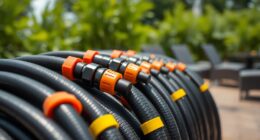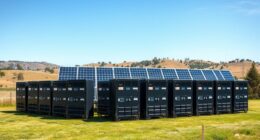To parallel solar panels without downtime, you should use a solar splitter designed for easy connections. This device allows you to add or disconnect panels safely without shutting down the entire system. Make sure to use proper wiring, fuse protections, and follow manufacturer instructions for correct setup. Monitoring your system’s voltage and current also helps prevent issues. Want to learn more about wiring best practices and managing batteries for peak performance? Keep exploring!
Key Takeaways
- Use a solar splitter to divide sunlight into multiple paths, enabling parallel connections without system shutdown.
- Connect panels to the splitter before integrating with the main system to prevent downtime.
- Incorporate appropriately rated wiring, fuses, and combiner boxes for safe, organized parallel setup.
- Ensure proper wiring polarity and configuration to avoid damage during expansion or maintenance.
- Monitor system performance and battery health regularly to maintain continuous operation during panel additions.
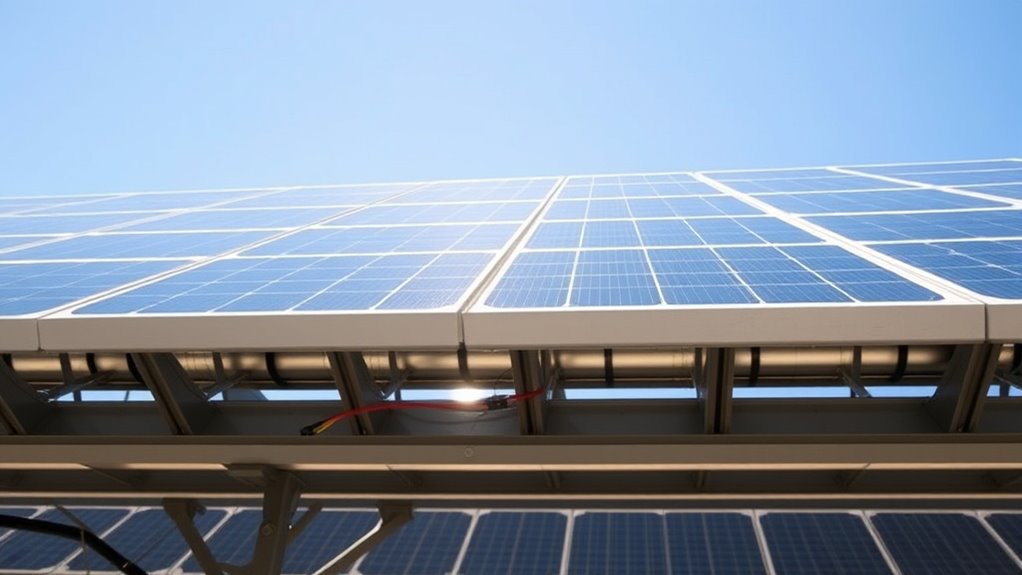
Solar splitters are innovative devices that enhance the efficiency of solar power systems by dividing sunlight into multiple pathways. They allow you to connect several panels in parallel without sacrificing performance, making it easier to expand your system or perform maintenance without causing downtime. When integrating solar splitters, you need to pay close attention to battery management and wiring configurations to guarantee optimal operation and longevity of your system.
Battery management becomes particularly important when you’re working with multiple panels connected through splitters. Properly managing your batteries helps prevent overcharging and deep discharges, which can damage your system over time. A well-designed setup includes a battery management system (BMS) that monitors voltage, current, and temperature levels across all batteries. This ensures each battery functions within safe parameters, maximizing lifespan and efficiency. When panels are split into different pathways, the BMS helps balance the load and prevents uneven charging that could lead to system failure. Keeping an eye on battery health also means you can identify and address issues early, maintaining a steady power supply and avoiding unexpected outages.
Effective battery management with splitters prevents overcharging, balances loads, and extends system lifespan.
Wiring configurations are equally critical when using solar splitters. You need to plan your wiring carefully to minimize losses and prevent potential hazards. Connecting panels in parallel through splitters requires consistent wiring setups—using appropriately rated wires and connectors designed for high current flow. Make sure your wiring configurations follow manufacturer guidelines, and consider using combiner boxes to neatly organize and protect connections. Proper wiring reduces resistance and prevents overheating, which could damage the panels or other system components. Additionally, consider incorporating fuses or circuit breakers in your wiring setup to protect against surges or short circuits, especially when expanding or modifying your system. Paying attention to wiring best practices is essential for ensuring safety and efficiency.
When you design your wiring configuration, keep in mind the distance between panels and your inverter or charge controller. Longer runs can increase resistance, leading to voltage drops that diminish overall efficiency. Using thicker wiring or shorter cables can help mitigate these effects. Also, ensure your system’s polarity is correct, as reversing connections can cause damage or system failure. By paying attention to these details, you ensure a safe, reliable, and efficient operation.
Frequently Asked Questions
Can Solar Splitters Be Used With All Types of Solar Panels?
When considering solar splitters, you wonder if they work with all solar panels. You need to check panel compatibility because not all panels support splitters, especially if they have different voltages or configurations. Be aware of splitter limitations, as mismatched panels or incompatible types can cause issues. Always verify manufacturer guidelines and confirm your panels are suitable for parallel wiring to avoid damage and optimize performance.
What Are the Maintenance Requirements for Solar Splitters?
Did you know proper maintenance can extend solar splitter lifespan by up to 30%? You should regularly follow cleaning protocols to keep connections free of dust and debris, ensuring peak performance. Additionally, firmware updates are essential—they fix bugs and improve efficiency. Check manufacturer guidelines for specific schedules, usually every 6 to 12 months. Staying on top of these tasks helps prevent downtime and keeps your solar system running smoothly.
How Does Parallel Connection Impact Overall System Efficiency?
Parallel connection can improve your system’s efficiency optimization by balancing current flow and reducing voltage drops. Proper wiring configurations ensure each panel contributes equally, preventing overloads or underperformance. When you connect panels in parallel, you maximize energy output during varying sunlight conditions, making your solar setup more dependable. Just make sure to use the correct wiring techniques and components, so your system runs smoothly and efficiently over time.
Are Solar Splitters Compatible With Existing Solar Setups?
You’ll find that solar splitter compatibility varies depending on your system’s design. When considering system integration considerations, check if your existing panels and inverter support splitters. Many modern systems are compatible, but you might need specific connectors or configurations. Ensuring compatibility prevents issues and simplifies installation. Always review manufacturer guidelines, and consult a professional if you’re unsure, to make sure your setup works seamlessly without causing downtime.
What Safety Precautions Should Be Taken When Installing Solar Splitters?
When installing solar splitters, you should prioritize electrical safety and handling precautions. Always turn off the system before starting, wear insulated gloves, and use proper tools to avoid shocks. Make certain you follow manufacturer instructions carefully and double-check connections. Keep the work area dry and clear of debris. By taking these handling precautions, you minimize risks and ensure a safe, efficient installation process.
Conclusion
Now that you know how to safely parallel your solar panels with splitters, you can enjoy uninterrupted power like a true pioneer of the modern age. Picture yourself as a daring explorer, charting new territory in renewable energy, all without the dread of downtime. With these tips, you’ll harness the sun’s power seamlessly—no more worries about interruptions. So go ahead, embrace the future of solar tech, and let your system shine brighter than a lighthouse guiding ships to safety.
